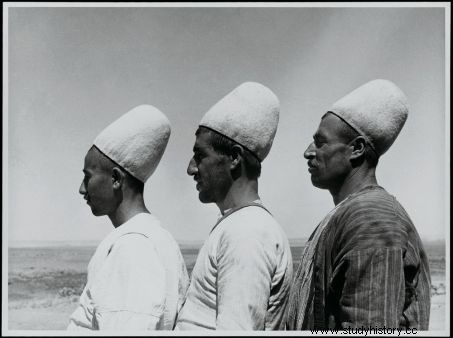A unique photographic collection is currently being digitized in Lebanon. Exceptional archaeological and ethnographic testimonies of a Middle East that has now disappeared.

Aerial photograph of the ancient site of Palmyra, Syria, taken by one of its pioneers, Antoine Poidebard, in 1938.
Treasure . It is an exceptional collection estimated at nearly 100,000 photographic documents that the Lebanese archaeologist Lévon Nordiguian digitizes at the Oriental Library of Saint-Joseph University in Beirut, the capital of the country. All were made by Jesuit fathers, from the end of the 19th th century until the 1960s. A heritage treasure made up of paper prints, glass plates and negatives, unique for Lebanon and the Middle East, which this passionate man has been patiently safeguarding for 20 years.

Archaeologist Levon Nordiguian in the corridors of the photo library of the Oriental Library of Saint-Joseph University, in Beirut. © Bernadette Arnaud
A dedicated photo library has just been inaugurated in the Ashrafieh district thanks to the participation of several French institutions and especially the partnership, since 2014, of the Boghossian Foundation. "Generations of Jesuits have accumulated photographs of all kinds:archaeological, historical, ethnographic. The oldest testimony we have dates back even to 1865 ", explains the former researcher of the French Institute of Archeology of the Near East (IFAPO), now responsible for these archives.

The Jesuit fathers during their travels, at the beginning of the XX th century. © Bernadette Arnaud
As part of their religious mission, the fathers indeed traveled a lot. This is how they criss-crossed the Beqaa plain, Lebanon, northern Syria, Sinai, Egypt, Armenia on mules... They took advantage of these missionary journeys to take stock by photographing them " in the chamber" (imposing bellows instruments of the time) ancient monuments or geological curiosities. The documents they brought back shed light on both the history of the Middle East and that of photography in this part of the world. There are even aerial photos taken between the wars by Antoine Poidebard (1878-1955) to whom the Laténium site in Neuchâtel (Switzerland) is currently devoting an exhibition*. These photos show in particular wonderful views of the city of Palmyra (Syria) that this pioneer of archaeological images had taken in 1938 thanks to innovative processes developed by this outstanding pilot.
The ethnographic photographs are the most moving:villages lost in the Lebanese mountains; Bedouins of the Syrian steppe; Circassians from the Caucasus or Alevi refugees in Turkey; Armenians before the massacres of 1915…

Three Yazidis photographed around the 1930s by Ph. H. Charles. © Photo library of the Oriental Library of USJ Beirut

Two Armenian schoolchildren photographed in Tokat, in present-day Turkey, around 1906. © Photo library of the Oriental Library of the USJ in Beirut
In the windows installed along a vast corridor with immaculate white walls, Lévon Nordiguian has also endeavored to expose the evolution of the material used by these explorers of souls as much as landscapes:"collodion to silver to albumen prints; from glass plates to flexible media or paper, it's all there" .

Magic lanterns and glass plates. © Bernadette Arnaud
The small museum thus provides an opportunity to discover the various devices used by the missionaries, but also the magic lanterns with which, during their travels, they projected images in front of amazed crowds who, most of the time, had never seen them.
* "Archives of the Sands , from Palmyra to Carthage », Laténium, Neuchâtel, (Switzerland) July 16, 2016- April 17, 2017.
